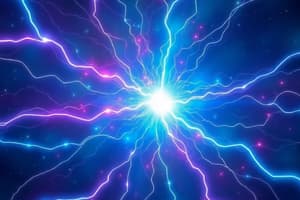Podcast
Questions and Answers
What is the fundamental relationship between the Earth's rotation and the distribution of solar energy?
What is the fundamental relationship between the Earth's rotation and the distribution of solar energy?
- The speed of rotation determines the amount of solar energy Earth receives in total.
- The rotation causes Earth to receive equal amounts of solar energy at all locations.
- The rotation distributes solar energy unevenly, causing temperature variations and climate zones. (correct)
- Rotation has no effect on solar energy distribution; only the atmosphere plays a role.
How did the Bedford Canal experiment contribute to the understanding of Earth's shape?
How did the Bedford Canal experiment contribute to the understanding of Earth's shape?
- It directly measured the polar and equatorial diameters to quantify Earth's oblateness.
- It provided visual evidence supporting the curvature of Earth. (correct)
- It mapped the ocean currents, which are influenced by Earth's rotation.
- It demonstrated that the horizon always appeared flat, disproving Earth's curvature.
How does the sighting of a ship approaching the land relate to the Earth's shape?
How does the sighting of a ship approaching the land relate to the Earth's shape?
- The mast of the ship is visible before the hull, suggesting a spherical shape. (correct)
- The entire ship is visible at once from a distance, indicating a flat Earth.
- The ship's reflection on the water proves the Earth is round.
- Ships disappear completely as they approach land due to the Earth's atmosphere.
What is the significance of the ozone layer within Earth's atmosphere?
What is the significance of the ozone layer within Earth's atmosphere?
How does the presence of water in three states (solid, liquid, and gas) contribute to the Earth's uniqueness?
How does the presence of water in three states (solid, liquid, and gas) contribute to the Earth's uniqueness?
Given that Earth is an oblate spheroid, what is the relationship between its equatorial and polar diameters?
Given that Earth is an oblate spheroid, what is the relationship between its equatorial and polar diameters?
How do satellite photographs taken from different locations in space confirm the Earth's shape?
How do satellite photographs taken from different locations in space confirm the Earth's shape?
Why is Earth considered a unique planet in the Solar System based on its distance from the Sun?
Why is Earth considered a unique planet in the Solar System based on its distance from the Sun?
What is the range of temperatures observed on Earth and how does it contribute to its habitability?
What is the range of temperatures observed on Earth and how does it contribute to its habitability?
Which statement accurately compares the day temperature on Mercury and Mars?
Which statement accurately compares the day temperature on Mercury and Mars?
How did the voyage of Ferdinand Magellan provide evidence supporting the Earth's shape?
How did the voyage of Ferdinand Magellan provide evidence supporting the Earth's shape?
How does the angle of elevation of the Pole Star vary with an observer's position on Earth, and what does this imply about Earth's shape?
How does the angle of elevation of the Pole Star vary with an observer's position on Earth, and what does this imply about Earth's shape?
Considering the Earth's tilt on its axis, what is the primary consequence regarding the distribution of solar radiation?
Considering the Earth's tilt on its axis, what is the primary consequence regarding the distribution of solar radiation?
How does the concept of a 'circular shadow' relate to Aristotle's argument for Earth's spherical shape?
How does the concept of a 'circular shadow' relate to Aristotle's argument for Earth's spherical shape?
How do the processes within the hydrosphere contribute to maintaining Earth's temperature?
How do the processes within the hydrosphere contribute to maintaining Earth's temperature?
Considering the atmospheric composition of Earth, why is it considered unique compared to other planets in the Solar System?
Considering the atmospheric composition of Earth, why is it considered unique compared to other planets in the Solar System?
In what way does the continuous flow of water on Earth contribute to the formation of ideal conditions for the development of life?
In what way does the continuous flow of water on Earth contribute to the formation of ideal conditions for the development of life?
How does the presence of the atmosphere around the Earth contribute to making life possible?
How does the presence of the atmosphere around the Earth contribute to making life possible?
What evidence supports the claim that Earth is not a perfect sphere?
What evidence supports the claim that Earth is not a perfect sphere?
Why is the Earth known as the 'blue planet'?
Why is the Earth known as the 'blue planet'?
Flashcards
Origin of the Universe
Origin of the Universe
The universe probably originated due to the Big Bang about 20 billion years ago.
The Sun
The Sun
A star containing heat and light; the main source of energy for Earth.
Planets in the Solar System
Planets in the Solar System
Mercury, Venus, Earth, Mars, Jupiter, Saturn, Uranus, and Neptune.
The Pole Star's position
The Pole Star's position
Signup and view all the flashcards
Circumnavigation Proof
Circumnavigation Proof
Signup and view all the flashcards
Biosphere
Biosphere
Signup and view all the flashcards
Earth's Shape
Earth's Shape
Signup and view all the flashcards
Main Gasses in Atmosphere
Main Gasses in Atmosphere
Signup and view all the flashcards
Ozone Layer in Atmosphere
Ozone Layer in Atmosphere
Signup and view all the flashcards
Earth's Location
Earth's Location
Signup and view all the flashcards
The Hydrological Cycle
The Hydrological Cycle
Signup and view all the flashcards
Study Notes
Vectors
- The moment of a force measures the tendency to cause rotation around a point.
Sum of Vectors
Graphic Method
- Vectors are placed sequentially, maintaining their magnitude, direction, and sense.
- The resultant vector goes from the origin of the first vector to the end of the last vector.
- $$\vec{R} = \vec{A} + \vec{B}$$
Analytical Method
- Concurrent vectors intersect at a single point.
- Vectors are decomposed into rectangular components along x and y axes.
- (A_x = A \cos\theta)
- (A_y = A \sin\theta)
- Components are summed along each axis:
- (R_x = A_x + B_x)
- (R_y = A_y + B_y)
- The resultant vector's magnitude and direction are calculated:
- (R = \sqrt{R_x^2 + R_y^2})
- (\theta = \arctan\left(\frac{R_y}{R_x}\right))
System of Linear Equations: Compatibility
Theory
Definition
- A system of linear equations (SEL) consists of m equations with n unknowns.
- $a_{11}x_1 + a_{12}x_2 + \dots + a_{1n}x_n = b_1$
- $a_{21}x_1 + a_{22}x_2 + \dots + a_{2n}x_n = b_2$
- ...
- $a_{m1}x_1 + a_{m2}x_2 + \dots + a_{mn}x_n = b_m$
- $x_1, x_2, \dots, x_n$ are unknowns.
- $a_{ij} \in \mathbb{R}$ are the coefficients, $i = \overline{1, m}, j = \overline{1, n}$.
- $b_i \in \mathbb{R}$ are the constants, $i = \overline{1, m}$.
Notations
Matrix Form
- $AX = B$
- $A$ is the system's matrix.
- $X$ is the matrix of unknowns.
- $B$ is the matrix of constants.
Augmented Matrix
- $\overline{A} = (A \mid B)$ includes both the coefficients and the constants.
Definitions
- A solution is an n-tuple $(s_1, s_2, \dots, s_n) \in \mathbb{R}^n$ that satisfies all equations.
- Solving a system means finding all solutions. The set of all solutions is denoted by $S$.
Compatibility of Linear Equation Systems
Definitions
- A system is compatible if it has at least one solution.
- A system is incompatible if it has no solutions.
- A compatible system is determined if it has one solution and undetermined if it has multiple solutions.
Kronecker-Capelli Theorem
- A system is compatible if and only if the rank of the matrix of the system equals the rank of the augmented matrix.
- $\text{rang}(A) = \text{rang}(\overline{A})$
Discussion of Compatibility and Number of Solutions
- Let $r = \text{rang}(A) = \text{rang}(\overline{A})$.
- If $r = n$, the system is compatible determined (one solution).
- If $r < n$, the system is compatible undetermined (infinitely many solutions).
Observations
- If $\text{rang}(A) < \text{rang}(\overline{A})$, the system is incompatible (no solutions).
- Homogeneous systems (all constants are zero) are always compatible.
- A system of $n$ equations with $n$ unknowns is a square system. If the determinant of the system's matrix is non-zero, the system is compatible and determined.
Statics
Force System Resultants
Main Topics
- Moment of a force.
- Principle of moments.
- Moment of a force about a specified axis.
- Simplification of a force and couple system.
- Further reduction of a force and couple system.
Moment of a Force Defined
- The moment of a force about a point measures the tendency of the force to cause rotation about that point.
Magnitude
- $M_O = Fd$, where:
- $F$ = force magnitude
- $d$ = moment arm (perpendicular distance)
Direction
- The moment vector $\overrightarrow{M_O}$ is perpendicular to the plane formed by the force $\overrightarrow{F}$ and moment arm $\overrightarrow{d}$.
- Direction is found using the right-hand rule.
Sense of Rotation
- Counterclockwise rotation: moment vector is directed out of the page.
- Clockwise rotation: moment vector is directed into the page.
- Right-hand rule: fingers curl in the direction of rotation, thumb points in the direction of the moment vector.
Varignon's Theorem
- The moment of a force is equal to the sum of the moments of the force's components: $\overrightarrow{M_O} = \overrightarrow{r} \times \overrightarrow{F} = \overrightarrow{r} \times (\overrightarrow{F_1} + \overrightarrow{F_2}) = \overrightarrow{r} \times \overrightarrow{F_1} + \overrightarrow{r} \times \overrightarrow{F_2}$
Algorithmic Game Theory
Definition
- Combines computer science (algorithm design and analysis) with game theory (mathematical study of strategic interactions).
- Uses computation to understand, predict, and design outcomes in strategic settings.
Selfish Routing
Model
- $G = (V, E)$: directed graph
- $r_e$: traffic rate on edge $e$
- $l_e(r_e)$: latency function for edge $e$
- $s_i, t_i$: source and sink for player $i$
- $\Gamma_i$: paths from $s_i$ to $t_i$
- $x_P$: flow of player $i$ along path $P \in \Gamma_i$
- $\sum_{P \in \Gamma_i} x_P = r_i$: total traffic of player $i$
- $r_e = \sum_{P: e \in P} x_P$: total traffic on edge $e$
Wardrop Equilibrium
- For all $i$ and all paths $P, P' \in \Gamma_i$ with $x_P > 0$: $\sum_{e \in P} l_e(r_e) \le \sum_{e \in P'} l_e(r_e)$. I.e., all flow is on min-latency paths.
Social Cost
- $SC(x) = \sum_{e \in E} r_e \cdot l_e(r_e)$ (total latency)
Price of Anarchy
- $PoA = \max_x \frac{SC(x)}{SC(x^)}$ where $x$ is Wardrop, $x^$ is socially optimal.
Braess's Paradox
- Adding an edge can worsen overall latency due to selfish behavior.
Theorem
- If latency functions are linear, $PoA \le \frac{4}{3}$.
The Chemistry of Life
The Elements of Life
- Life is mostly (96%) carbon, hydrogen, oxygen, and nitrogen.
- The remaining 4% mainly consists of calcium, phosphorus, potassium, and sulfur.
- Trace elements are required in very small amounts.
The Importance of Chemical Bonds
- An atom's characteristics determine how it interacts with others.
- Electronegativity is an atom’s attraction for electrons in a covalent bond.
- Nonpolar covalent bond: electrons shared equally (similar electronegativity).
- Polar covalent bond: unequal sharing (one atom is more electronegative).
- Ionic bond: attraction between ions.
- Van der Waals interactions: Weak attractions from transient partial charges.
Studying That Suits You
Use AI to generate personalized quizzes and flashcards to suit your learning preferences.



